
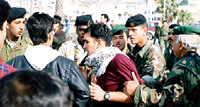
Above: Students arguing with the Palestinian police preventing them from passing
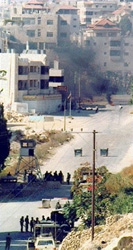
Many Birzeit students want to demonstrate against the Israeli moves in Abu Ghnaim. Elections are looming and seeing Birzeit student factions agree on any joint activities during the run-up period is unlikely. Everyone is too busy trying to score political points with activities they can claim as the work of their faction alone.
Somehow, all the blocs manage to agree on a demonstration except the Islamic Bloc. They believe that demonstrations against the Har Homa project on Jebal Abu Ghnaim will help the Palestinian Authority (PA). That they may help the Palestinian people as well is not as important here as giving the PA, perceived to be collaborating and/or giving too many concessions to the Israelis, any political victories.
This means the three-party left-wing coalition and Shabibi, the student wing of Arafat's Fatah faction - between them representing more than half of the student body - are going to march together to the Ma'alufiyya area to demonstrate, site of the clashes last September (pictured left).
The Israelis called their checkpoint there the "Arak Checkpoint" (since reduced to a single jeep further down the road towards Jerusalem), since a factory that makes this Palestinian moonshine is found there. The Arabic result of this alcohol landmark-naming game is Al-Khammara ("The place where they make alcohol").
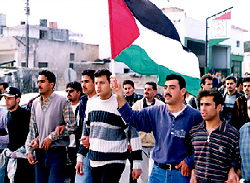
The buses of students zoom off to the Manara in Ramallah and pile out. The Palestinian police haven't yet worked out that they are on the way, probably because their usual informers - Shabiba students who work for the security forces - are part of this particular demonstration and therefore the police don't manage to stop them. I get out of the bus with Yasser Darweesh, the university photographer, and we quickly stop off at the Studio Al-Manara to buy some film.
As the students set off towards Ma'alufiyya, passing Ramallans join in the march. I spot Ahmed (pictured right, to the left of the flag), the student who got a rubber-coated metal bullet in his eye cavity during the September clashes. He is at the front of the demonstration. I also see Atlal, the female student who works for Al-Hayat newspaper. She was shot in the abdomen last September. I tell both of them to be careful, with a smile.
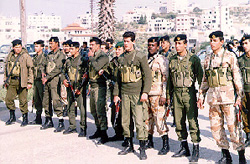
The Palestinian police are slowly working out that something is going on and start deploying troops (pictured left) to the area where the students are heading. Naturally, it is too little, too late.
After a few scuffles, the police manage to prevent students going directly via the road but can't stop them taking off and heading up over the mountains on either side. As small scuffles between police and latecomers continue in their wake, we follow the main body of students.
This is the point at which things will begin to get interesting.


Yasser heads off straight. Myself and Hanan, who I met somewhere in Ramallah, go off to the right and up the mountain. I have borrowed Kifah's camera and therefore for once don't need to worry about lens swapping. What makes this a real chore usually is that my camera, an old Fujica, has screw rather than bayonet fittings. Not something you want to be fiddling with when people are trying to kill each other all around you.
Hanan is using one of the digital cameras, although without the zoom extensions, clashes are not the best place to use them. Unless you are right up close, it's too far away, and right up close is where you don't want to be.
Compared to the working photographers from the local and international press, we are ill-equipped. They have zoom lenses half a mile long that require a supporting pole. "One day," I think to myself.
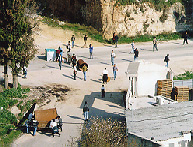
Up on the mountain, the view of the topography is very good. Looming over Ramallah behind the students up on the mountain, the settlement on Jebal Al-Taweel is an appropriate backdrop for this demonstration's theme.
Students on the main road to Jerusalem below are blocking the road with porta-toilets, rubbish skips, barrels, and anything else they can get their hands on (pictured right). Some set fire to the barricade while others plant a Palestinian flag on the top of the "Welcome to Area A" sign in an act of irony.
Although since February only a single jeep has remained at the former Khammara checkpoint, the students predict that it will quickly be joined by others once they show up. They are right. As if scripted, the soldiers in the jeep take one look at the approaching students before leaving swiftly and returning five minutes later with reinforcements.